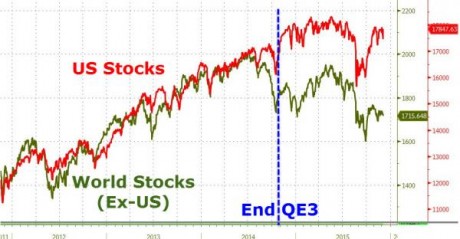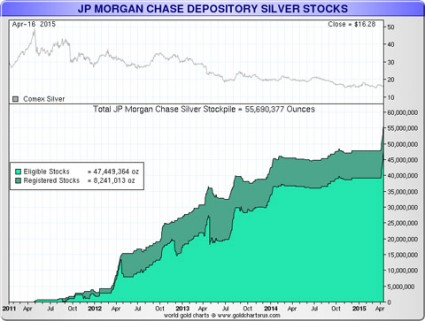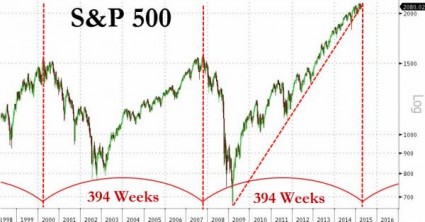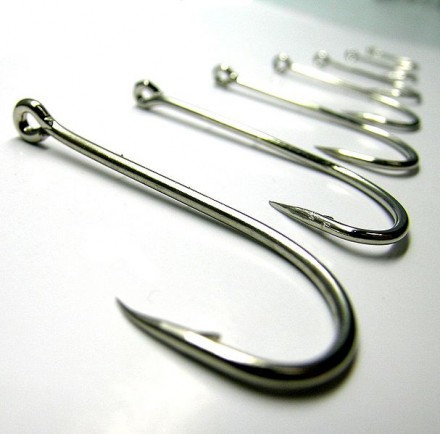 Rampant silver manipulation? Rampant gold manipulation? Rampant LIBOR manipulation? Hiding MF Global client assets? These are all happening at JP Morgan according to an open letter reportedly written by an anonymous employee of the firm. The whistleblower also warns of a “cascading credit event being triggered” by derivatives related to Greek government debt. Unlike Greg Smith at Goldman Sachs, this whistleblower has chosen to remain anonymous for now. According to the letter, the whistleblower is still an employee of JP Morgan and has not resigned. But that does make it much more difficult to confirm what he is saying. With Greg Smith, we know exactly who he is and what he was doing at Goldman. As far as this anonymous whistleblower is concerned, all we have is this letter. So we must take it with a grain of salt. However, the information in this letter does agree with what whistleblowers such as Andrew Maguire have said in the past about silver manipulation by JP Morgan. And this letter does mention Greg Smith’s resignation from Goldman, so we know that it must have been written in the past few days. Hopefully this letter will cause authorities to take a much closer look at the crazy things that are going on over at JP Morgan and the other big Wall Street banks.
Rampant silver manipulation? Rampant gold manipulation? Rampant LIBOR manipulation? Hiding MF Global client assets? These are all happening at JP Morgan according to an open letter reportedly written by an anonymous employee of the firm. The whistleblower also warns of a “cascading credit event being triggered” by derivatives related to Greek government debt. Unlike Greg Smith at Goldman Sachs, this whistleblower has chosen to remain anonymous for now. According to the letter, the whistleblower is still an employee of JP Morgan and has not resigned. But that does make it much more difficult to confirm what he is saying. With Greg Smith, we know exactly who he is and what he was doing at Goldman. As far as this anonymous whistleblower is concerned, all we have is this letter. So we must take it with a grain of salt. However, the information in this letter does agree with what whistleblowers such as Andrew Maguire have said in the past about silver manipulation by JP Morgan. And this letter does mention Greg Smith’s resignation from Goldman, so we know that it must have been written in the past few days. Hopefully this letter will cause authorities to take a much closer look at the crazy things that are going on over at JP Morgan and the other big Wall Street banks.
This anonymous letter was addressed to the CFTC, but unfortunately it looks like the CFTC has already chosen to ignore it.
The original letter from this anonymous whistleblower has already been taken down from the CFTC website. When you go there now, all you get is this message….
“The Comment Cannot Be Found. Please Return to the Previous Page and Try Again.”
Fortunately, there are many in the alternative media that copied this entire letter from the CFTC website.
The following is a copy of the original letter that the anonymous whistleblower from JP Morgan submitted to the CFTC….
———-
Dear CFTC Staff,
Hello, I am a current JPMorgan Chase employee. This is an open letter to all commissioners and regulators. I am emailing you today b/c I know of insider information that will be damning at best for JPMorgan Chase. I have decided to play the role of whistleblower b/c I no longer have faith and belief that what we are doing for society is bringing value to people. I am now under the opinion that we are actually putting hard working Americans unaware of what lays ahead at extreme market risk. This risk is unnecessary and will lead to wide-scale market collapse if not handled properly. With the release of Mr. Smith’s open letter to Goldman, I too would like to set the record straight for JPM as well. I have seen the disruptive behavior of superiors and no longer can say that I look up to employees at the ED/MD level here at JPM. Their smug exuberance and arrogance permeates the air just as pungently as rotting vegetables. They all know too well of the backdoor crony connections they share intimately with elected officials and with other institutions. It is apparent in everything they do, from the meager attempts to manipulate LIBOR, therefore controlling how almost all derivatives are priced to the inherit and fraudulent commodities manipulation. They too may have one day stood for something in the past in the client-employee relationship. Does anyone in today’s market really care about the protection of their client? From the ruthless and scandalous treatment of MF Global client asset funds to the excessive bonuses paid by companies with burgeoning liabilities. Yes, we at JPMorgan that are in the know are fearful of a cascading credit event being triggered in Greece as they have hidden derivatives in excess of $1 Trillion USD. We at JPMorgan own enough of these through counterparty risk and outright prop trading that our entire IB EDG space could be annihilated within a few short days. The last ten years has been market by inflexion point after inflexion point with the most notable coming in 2008 after the acquisition of Bear.
I wish to remain anonymous as of now as fear of termination mounts from what I am about to reveal. Robert Gottlieb is not my real name; however he is a trader that is involved in a lawsuit for manipulative trading while working with JPMorgan Chase. He was acquired during our Bear Stearns acquisition and is known to be the notorious person shorting in the silver future market from his trading space, along with Blythe Masters, his IB Global boss. However, with that said, we are manipulating the silver futures market and playing a smaller (but still massively manipulative) role in manipulating the gold futures market. We have a little over a 25% (give or take a percentage) position in the short market for silver futures and by your definition this denotes a larger position than for speculative purposes or for hedging and is beyond the line of manipulation.
On a side note, I do not work directly with accounts that would have been directly impacted by the MF Global fiasco but I have heard through other colleagues that we have involvement in the hiding of client assets from MF Global. This is another fraudulent effort on our part and constitutes theft. I urge you to forward that part of the investigation on to the respective authorities.
There is something else that you may find strange. During month-end December, we were all told by our managers that this was going to be a dismal year in terms of earnings and that we should not expect any bonuses or pay raises. Then come mid-late January it is made known that everyone received a pay raise and/or bonus, which is interesting b/c just a few weeks ago we were told that this was not likely and expected to be paid nothing in addition to base salary. January is right around the time we started increasing our short positions quite significantly again and this most recent crash in gold and silver during Bernanke’s speech on February 29th is of notable importance, as we along with 4 other major institutions, orchestrated the violent $100 drop in Gold and subsequent drops in silver.
As regulators of the free people of this country, I ask you to uphold the most important job in the world right now. That job is judge and overseer of all that is justice in the most sensitive of commodity markets. There are many middle-income people that invest in the physical assets of silver, gold, as well as mining stocks that are being financially impacted in a negative way b/c of our unscrupulous shorts in the precious metals commodity sector. If you read the COT with intent you will find that commercials (even though we have no business being in the commercial sector, which should be reserved for companies that truly produce the metal) are net short by a long shot in not only silver, but gold.
It is rather surprising that what should be well known liabilities on our balance sheet have not erupted into wider scale scrutinization. I call all honest and courageous JPMorgan employees to step up and fight the cronyism and wide-scale manipulation by reporting the truth. We are only helping reality come to light therefore allowing a real valuation of our banking industry which will give investors a chance to properly adjust without being totally wiped out. I will be contacting a lawyer shortly about this matter, as I believe no other whistleblower at JPMorgan has come forward yet. Our deepest secrets lie within the hands of honest employees and can be revealed through honest regulators that are willing to take a look inside one of America’s best kept secrets. Please do not allow this to turn into another Enron.
Kind Regards,
-The 1st Whistleblower of Many
———-
Another Enron?
If what this letter says is true, then the problems facing our financial system are more serious than most of us thought.
And the allegations of corruption at JP Morgan are absolutely shocking.
But this is not the first whistleblower to come forward to the CFTC with charges of rampant market manipulation by JP Morgan.
Back in 2010 I wrote about the stunning allegations that a former silver trader named Andrew Maguire presented to the CFTC. The following is an extended excerpt from that article….
———-
Back in November 2009, Andrew Maguire, a former Goldman Sachs silver trader in Goldman’s London office, contacted the CFTC’s Enforcement Division and reported the illegal manipulation of the silver market by traders at JPMorgan Chase.
Maguire told the CFTC how silver traders at JPMorgan Chase openly bragged about their exploits – including how they sent a signal to the market in advance so that other traders could make a profit during price suppression episodes.
Traders would recognize these signals and would make money shorting precious metals alongside JPMorgan Chase. Maguire explained to the CFTC how there would routinely be market manipulations at the time of option expiries, during non-farm payroll data releases, during commodities exchange contract rollovers, as well as at other times if it was deemed necessary.
On February 3rd, Maguire gave the CFTC a two day warning of a market manipulation event by email to Eliud Ramirez, who is a senior investigator for the CFTC’s Enforcement Division.
Maguire warned Ramirez that the price of precious metals would be suppressed upon the release of non-farm payroll data on February 5th. As the manipulation of the precious metals markets was unfolding on February 5th, Maguire sent additional emails to Ramirez explaining exactly what was going on.
And it wasn’t just that Maguire predicted that the price would be forced down. It was the level of precision that he was able to communicate to the CFTC that was the most stunning. He warned the CFTC that the price of silver was to be taken down regardless of what happened to the employment numbers and that the price of silver would end up below $15 per ounce. Over the next couple of days, the price of silver was indeed taken down from $16.17 per ounce down to a low of $14.62 per ounce.
Because of Maguire’s warning, the CFTC was able to watch a crime unfold, right in front of their eyes, in real time.
So what did the CFTC do about it?
Nothing.
Absolutely nothing.
———-
You can read the rest of that article right here.
So will the CFTC do anything about all of this?
Based on past history, probably not.
Basically, the CFTC is a government agency that appears to do next to nothing.
Another scandal involving JP Morgan has come out in recent days as well.
This one involves their credit card division. If you have a moments, you should really read the recent American Banker expose of credit card debt collection practices at JPMorgan Chase. It exposes some things that will absolutely blow your mind.
Linda Almonte, a former executive at JPMorgan Chase’s Credit Card Litigation Support Group, has revealed some incredible stuff regarding the debt collection practices at the company. Almonte says that she was shocked at what she saw when she began examining the details of a $200 million package of debt collection judgments to an outside debt collection agency….
Nearly half of the files her team sampled were missing proofs of judgment or other essential information, she wrote to colleagues. Even more worrisome, she alleged in her wrongful-termination suit, nearly a quarter of the files misstated how much the borrower owed.
In the “vast majority” of those instances, the actual debt was “lower that what Chase was representing,” her suit stated.
Almonte says that she warned that this sale of debt collection judgments must be stopped, but that a company executive told her that “she had better go along with the plan to sell the misrepresented asset“.
Almonte refused to go along, and she was fired on November 30th, 2009.
You are probably thinking that this sounds very much like the “robo-signing” foreclosure scandal and you would be right.
The more we dig into these giant financial companies the more corruption we find.
It really is shocking.
And remember, JPMorgan Chase is also the company that makes more money whenever the number of Americans on food stamps goes up.
JPMorgan Chase issues food stamp debit cards in 26 U.S. states and the District of Columbia, and they actually want more Americans to go on food stamps so that they can make bigger profits from the division that issues them.
So now are you starting to understand why so many Americans are upset about the corruption on Wall Street?
This isn’t a “conservative issue” or a “liberal issue” – it is an American issue and the outrageous behavior of these firms has brought our financial system once again to the edge of disaster.
Over the past six months, more than 350 prominent executives have resigned from major banks and financial institutions all over the globe.
Is this a sign that the rats are fleeing a sinking ship?
Do they know something that we don’t?
What we do know is that the financial crisis in Greece is far from over and the European financial system is getting closer to a complete meltdown with each passing day.
Very few of the things that caused the financial crisis of 2008 were ever corrected and our financial system is even more vulnerable today than it was back then.
In the end, this entire pyramid of debt, leverage and corruption is going to come crashing down really hard, and the consequences are going to be absolutely catastrophic.

 As we approach the end of 2015, researchers at both JP Morgan and Citigroup agree that the probability that the U.S. economy will soon plunge into recession is rising. Just last week, a member of the U.S. House of Representatives asked Janet Yellen about Citigroup’s assessment that there is a 65 percent chance that the United States will experience an economic recession in 2016. You can read her answer below. And just a few days ago, JP Morgan economists Michael Feroli, Daniel Silver, Jesse Edgerton, and Robert Mellman released a report in which they declared that “the probability of recession within three years” has risen to “an eye-catching 76%”…
As we approach the end of 2015, researchers at both JP Morgan and Citigroup agree that the probability that the U.S. economy will soon plunge into recession is rising. Just last week, a member of the U.S. House of Representatives asked Janet Yellen about Citigroup’s assessment that there is a 65 percent chance that the United States will experience an economic recession in 2016. You can read her answer below. And just a few days ago, JP Morgan economists Michael Feroli, Daniel Silver, Jesse Edgerton, and Robert Mellman released a report in which they declared that “the probability of recession within three years” has risen to “an eye-catching 76%”…
















